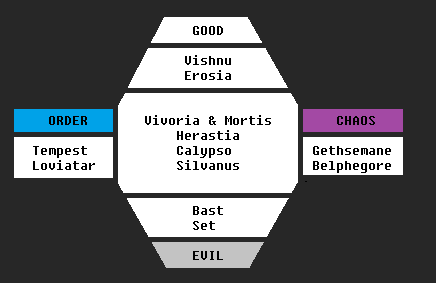Difference between revisions of "Axis"
(→Morality: linkifying) |
(adding alternative text) |
||
| (6 intermediate revisions by one other user not shown) | |||
| Line 170: | Line 170: | ||
|} | |} | ||
[[Category:Axis]] | [[Category:Axis]] | ||
| + | |||
| + | ==Primitive Representation of Axis Relationships== | ||
| + | |||
| + | This is a primitive representation of Axis relationships created by a mortal artist. | ||
| + | |||
| + | [[File:AxisImage.png|alt=A chart displaying the different axes in Threshold. On the top, for Good, it displays Vishnu and Erosia. On the bottom, for Evil, it displays Set and Bast. On the left, for Order, it displays Tempest and Loviatar. On the right, for Chaos, it displays Gethsemane and Belphegore. In the centre, unaligned with any of the four axes, is Vivoria, Mortis, Herastia, Calypso, and Silvanus.]] | ||
Latest revision as of 21:40, 25 December 2023
The Axis system is essentially two component measure of a character's outlook. There are two axes, morality and harmony. Morality describes your ethical viewpoint, such as evil or good. Harmony describes your philosophical viewpoint, such as order or chaos.
The player chooses both of these for his character by way of the Axis command. Certain in-game organizations and relationships have axis requirements that a character must meet before they may participate in them. Most notably churches and clans. In addition, some interpersonal relationships are also governed by a character's axis definition, such as bloodoaths, marriage, and even partying.
Terminology
The following terminology exists to describe the different elements of the axis system.
Ethos
The sum and total of the morality and harmony of your mortal soul.
Morality
Harmony
Order and Chaos. Also: harmonic.
Axis
Either of the two categories, Morality or Harmony.
Primary Axis
Morality or Harmony. The axis of ethos that your character cares about the most.
Disposition
A single choice: Good, Evil, Order, or Chaos. Clans have this.
Ethos rules
As mentioned above, different ethoi determine what organizations and interpersonal relationships are available to a character.
Partying
You cannot party with anyone whose primary ethos (good, evil, order, or chaos) conflicts with yours.
If someone is primary/morality/good they cannot party with someone who is primary/morality/evil, but they can party with someone who is secondary/morality/evil and primary/harmony/order or chaos.
If someone is primary/harmony/chaos they cannot party with someone who is primary/harmony/order, but they can party with someone who is secondary/harmony/order and primary/morality/good or evil.
If your primary axis is morality/good, you cannot party with anyone primary/evil. You can party with people who are secondary/evil, but that should only be done in limited cases with sufficient RP justification. You should not routinely party (or borg) with characters that conflict with your primary ethos choice (having a different primary axis is fine).
Any time you party with someone whose primary conflicts with your secondary, there is some measure of concern. That should happen infrequently.
Marriage
Spouses cannot conflict with each other's primary choice in either axis, but they do not have to have the same primary axis, and they can conflict with each other's secondary axis.
Good/any harmonic can marry Good/any harmonic Good/any harmonic can marry Any harmonic/good. Good/any harmonic cannot marry someone who has evil as primary or secondary.
Bloodoaths
Bloodoaths must have the same MORALITY and the same HARMONIC, but they can differ on which one is their primary.
For example:
Character 1: primary morality/evil, secondary harmonic/order Character 2: primary harmonic/order, secondary morality/evil
These characters can bloodoath.
Clans
Clans have a DISPOSITION. This is Good, Evil, Order, or Chaos. They do not have primary or secondary ethos.
A clan's disposition is set by the founder during initial clan formation in the Hall of Clans. If any party members forming the clan violate the disposition of the clan, formation fails.
A clan's disposition may be modified by the founder via the clanmanage command.
Clan members may view the clan's disposition via the clanmanage command.
Members of a clan cannot conflict with the clan's disposition in either their morality or their harmonic. It doesn't matter if the conflict is primary or secondary.
If your clan's disposition is GOOD, then members cannot be primary/evil or secondary/evil. They can be order or chaos.
If your clan's disposition is CHAOS, then members cannot be primary/order or secondary/order. They can be good or evil.
Religion
The below chart details the axis requirements for the various deities of the pantheon. If a cell is blank, then there is no requirement of that type.
| Deity | Primary
Axis |
Morality | Harmony | Special |
|---|---|---|---|---|
| Vishnu | Morality | Good | Cleric must be Order
Paladin must be Order Followers encouraged to be Order | |
| Erosia | Good | |||
| Tempest | Harmony | Order | ||
| Loviatar | Harmony | Order | ||
| Gethsemane | Harmony | Chaos | ||
| Belphegore | Harmony | Chaos | ||
| Set | Morality | Evil | Cleric must be Order
Paladin must be Order Followers encouraged to be Order | |
| Bast | Evil | |||
| Herastia | ||||
| Vivoria | ||||
| Calypso | Chaos | Alchemist may be Order
Mage may be Order Psion may be Order Templar may be Order | ||
| Silvanus | Followers tend to be good, but not enforced by code. | |||
| Mortis |
Primitive Representation of Axis Relationships
This is a primitive representation of Axis relationships created by a mortal artist.
